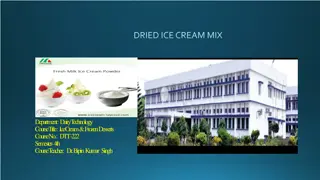Insights into Milk Composition and Processing
Worldwide, milk is collected from various animals such as cows, goats, sheep, yaks, and water buffalo. The composition of milk includes water, lactose, butterfat, protein, and minerals, each playing a vital role in its nutritional value. The butterfat content determines the richness of dairy product
7 views • 41 slides
Significance of Raw Materials in Food Processing
Effective selection of raw materials is crucial for ensuring the quality of processed food products. The quality of raw materials directly impacts the final products, making it important to procure materials that align closely with processing requirements. Quality evaluation, including microbiologic
2 views • 30 slides
Investigating the Impact of Pineapple Enzyme Bromelain on Gelatin and Pasteurization Process
Explore the effects of pineapple enzyme bromelain on gelatin and how pasteurization can alter its effectiveness in this lab experiment. Discover the different outcomes when using fresh versus canned pineapple and formulate hypotheses to guide the investigation. Follow step-by-step procedures to test
0 views • 15 slides
Comprehensive Guide to Ice Cream Mix Preparation in Dairy Technology
Ice cream mix preparation is a crucial process involving selection of ingredients, formulation, blending, pasteurization, homogenization, cooling, and aging. Key components like dairy and non-dairy ingredients are carefully chosen to achieve the desired flavor, texture, and quality in the final ice
1 views • 19 slides
Milk Processing Methods and Pasteurization Overview by Dr. Sushma Kumari
Milk processing involves filtration, clarification, and standardization to adjust fat and SNF levels. Pasteurization methods such as Batch, HTST, Vacuum, Stassanization, UHT, and Uperization ensure milk safety. Dr. Sushma Kumari from Bihar Animal Sciences University provides detailed insights into m
3 views • 10 slides
Dried Ice Cream Mix in Dairy Technology: Advancements and Manufacturing Process
Ice cream manufacturing faces challenges during lean seasons due to milk shortages. Dried ice cream mix powder offers a solution with benefits like reduced storage space, ease of packaging, and lower transportation costs. The composition includes milk fat, protein, sucrose, stabilizers, and emulsifi
1 views • 13 slides
Overview of Egg Processing and Functional Properties
Egg processing involves the production of various convenience forms of eggs for commercial, food service, and home use, including refrigerated liquid products, frozen products, and dried or specialty products. The process includes washing, breaking, pasteurization, and classification into different
0 views • 11 slides
Milk Preservation Techniques and Methods
Milk can be preserved using various techniques such as chilling, pasteurization, and chemical preservation methods like hydrogen peroxide. The shelf life of milk can be extended by cooling or utilizing the lactoperoxidase system. Germicidal properties of fresh milk and naturally occurring inhibitory
4 views • 16 slides
Dairy Technology Class Lecture Overview
Adjustment of fat content in cream through standardization, pasteurization to ensure safety, and neutralization for butter making are key processes discussed in this informative dairy technology class lecture by Dr. Sanjeev Kumar, Associate Professor at SGIDT, Patna-14.
0 views • 13 slides
The Effects of High Temperatures on Microorganisms in Food Preservation
High temperatures are utilized to preserve food by affecting microorganisms. Heating can lead to various outcomes such as heat shock, sublethal injury, or cell death in microbial cells and spores. The mechanisms of damage include loss of permeability, denaturation of key components, and inability to
0 views • 18 slides
Principles and Methods of Pasteurization in Dairy Technology
Pasteurization is a critical process in the dairy industry, named after Louis Pasteur. It involves heating milk to specific temperatures and durations to eliminate harmful microorganisms while preserving the product's quality. Important for ensuring milk safety, pasteurtization has limitations and v
1 views • 11 slides
Controlling Microorganisms in Milk for Quality and Safety
Raw milk contains various microorganisms, and efficient cooling to 4°C post-milking is essential. Heat treatment methods like pasteurization, ultrapasteurization, and UHT processing help control bacterial numbers. Techniques such as centrifugation, filtration, and additional methods like carbon dio
0 views • 9 slides
The Biochemistry of Milk: Components, Processing, and Health Benefits
Delve into the intricate world of milk biochemistry with a focus on its components, processing methods, and health implications. Learn about the proteins, fats, carbohydrates, minerals, and vitamins present in milk, as well as how they contribute to its complex nature. Discover the various processes
0 views • 15 slides
Microbial Growth Inhibition in Medical Microbiology
Exploring the concepts of microbicidal vs. microbistatic processes, sterilization vs. disinfection methods, pasteurization, sanitization, and various physical methods used to inhibit microbial growth in medical settings. Heat treatment is highlighted as a common and effective method for sterilizatio
0 views • 36 slides
Sterilization and Disinfection Methods in Microbiology
Sterilization and disinfection are crucial processes in microbiology to eliminate all microorganisms and prevent their spread. Methods such as heat, ethylene oxide gas, and filtration are employed to achieve sterilization. Physical agents like heat through dry heat, flaming, and hot air ovens, as we
0 views • 27 slides
Applications of Ion Implantation and Electron Beam Processing in Various Industries
Ion implantation and electron beam processing play crucial roles in industries such as semiconductor manufacturing, food preservation, surface hardening, waste treatment, and gemstone color modification. These processes involve the use of accelerators to deposit ions or generate electron beams for p
0 views • 20 slides
Heat Exchangers in Food Operations and Equipment
Explore the world of heat exchangers used in food operations, including pasteurization, blanching, evaporation, drying, sterilization, freezing, and extrusion. Learn about different types of heat exchange equipment such as double tube heat exchangers, shell and tube heat exchangers, and plate heat e
0 views • 40 slides
Impact of Critical Process on Pathogen Entry and Survival in Ice Cream Manufacturing
The critical processes in ice cream manufacturing, such as pasteurization, homogenization, and chilling, play a crucial role in reducing pathogens and microorganisms, ensuring product safety. Pasteurization at specific temperatures and times effectively eliminates pathogenic organisms, while homogen
0 views • 9 slides

















